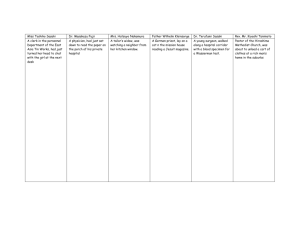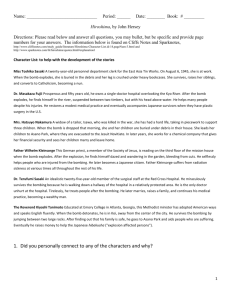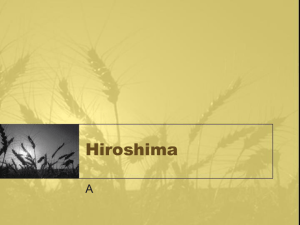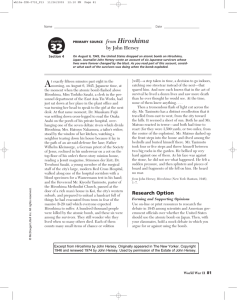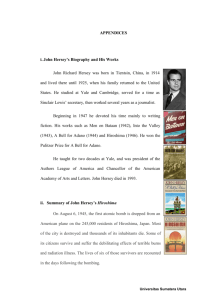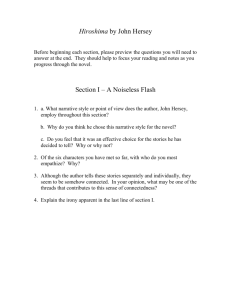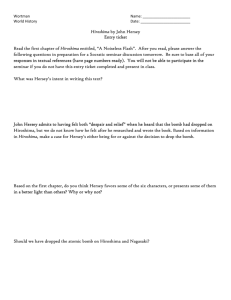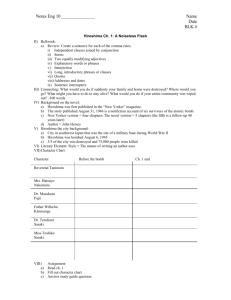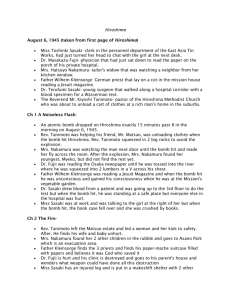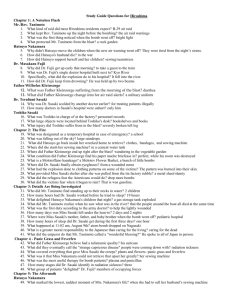Hiroshima Reading Guide
advertisement
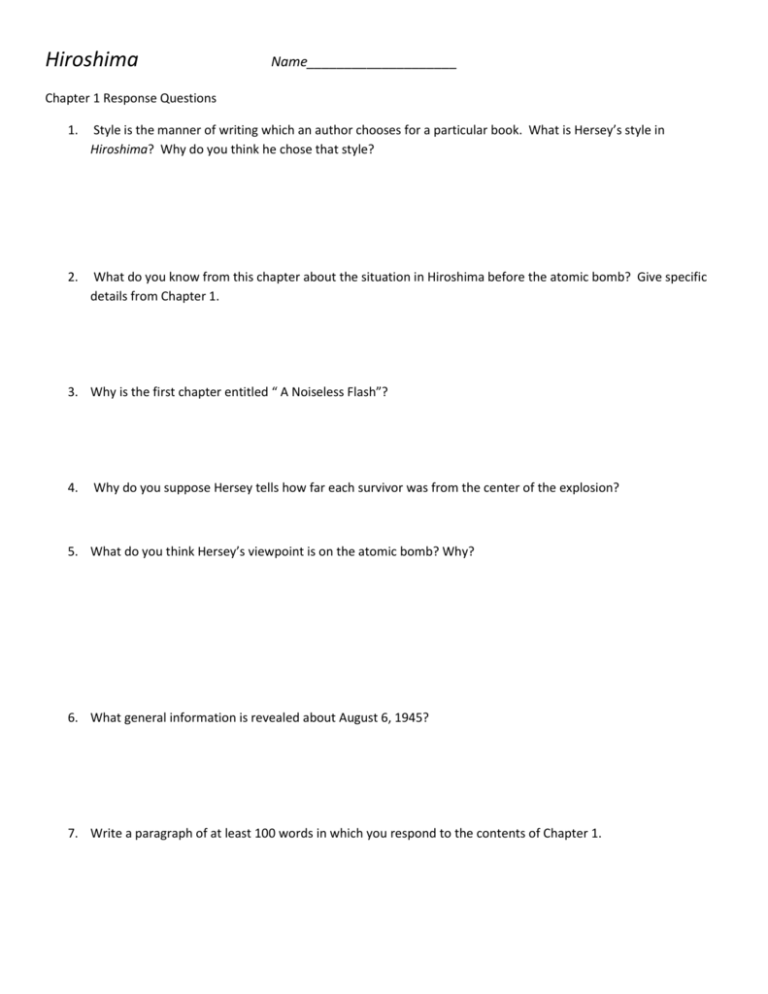
Hiroshima Name____________________ Chapter 1 Response Questions 1. Style is the manner of writing which an author chooses for a particular book. What is Hersey’s style in Hiroshima? Why do you think he chose that style? 2. What do you know from this chapter about the situation in Hiroshima before the atomic bomb? Give specific details from Chapter 1. 3. Why is the first chapter entitled “ A Noiseless Flash”? 4. Why do you suppose Hersey tells how far each survivor was from the center of the explosion? 5. What do you think Hersey’s viewpoint is on the atomic bomb? Why? 6. What general information is revealed about August 6, 1945? 7. Write a paragraph of at least 100 words in which you respond to the contents of Chapter 1. Hiroshima Name____________________ Chapter 2 “The Fire” Response Questions 1. Define the word “conflagration.” Compare the words conflagration and fire. 2. What is the chapter title’s meaning? 3. How are the six survivors similar? 4. How do these react toward family? Tanimoto Nakamura Kleinsorge 5. Who is Mrs. Kamai? What adjective would you use to describe her situation? 6. Who is Yoshida? How does he react after the bomb? 7. Who is Fukai? How does he react? 8. How are the six survivors different than Kamai, Yoshida, and Fukai? 9. Write a paragraph of at least 100 words in which you respond to the contents of Chapter 2. Hiroshima Name____________________ Chapter 3: “Details Are Being Investigated” 1. As you read this chapter, create a list of three to five vivid pictures Hersey creates which you consider to have the greatest impact. How do these descriptions affect you as the reader? 2. What encouraging news is relayed by the Japanese naval launch? What is disappointing about this news? 3. What is discovered about Mr. Fukai’s reason for running back into the burning city? 4. How did Mr. Tanimoto describe the Japanese Emperor’s surrender and notice to the Japanese people? 5. How did Dr. Sasaki deal with the fatalities at the Red Cross Hospital? What does this show of the typical Japanese way of handling death? 6. How is Mr. Tanimoto’s ministering to Mr. Tanaka a study in contrasts? 7. What does this quote and the rest of the conversation related to it show about medical priorities in the face of many injuries? “Why have you not come to Asano Park? You are badly needed there.” Without even looking up from his work, the doctor said in a tired voice, “This is my station.” 8. What is the significance of the title of Chapter Three? 9. Write a one paragraph reaction to anything you read in Chapter 3. Hiroshima Name____________________ Chapter 4: “Panic Grass and Feverfew” 1. What were some of the symptoms of the mysterious, capricious disease which was called radiation disease? 2. What were the reactions of those who treated radiation disease and of those afflicted with the disease? 3. What were the stages of radiation disease? 4. What were some of the views about the ethics of using the atomic bomb? What was the opinion of each of the following Hersey’s survivors? Nakamura – Fujii – Dr. SasakiKleinsorge- 5. How did Father Kleinsorge minister to the people of Hiroshima after the explosion? 6. How did Miss Sasaki’s fiancé react to her injuries? Was he justified in his reaction? Why? 7. Answer on back. What is the significance of the following quotation? Of what literary philosophy is it an example? Over everything—up through the wreckage of the city, in gutters, along the riverbanks, tangled among tiles and tin roofing, climbing on charred tree trunks—was a blanket of fresh, vivid, lush, optimistic green; the verdancy rose even from the foundations of ruined houses. Weeds already hid the ashes, and wild flowers were in bloom among the city’s bones. The bomb had not only left the underground organs of the plants intact; it had stimulated them. 8. Write a one paragraph reaction to anything you read in Chapter 4. Hiroshima Name____________________ Chapter 5: “The Aftermath” 1. What is different about the organization of this chapter? Hatsuyo Nakamura 2. What was Mrs. Nakamura’s struggle? 3. Who were the hibakusha? Tell some of the problems they faced. 4. How did the A-Bomb Victims Medical Care Law affect Mrs. Nakamura? Dr. Terufumi Sasaki 5. What does the old Japanese saying, “Check an old iron bridge well before crossing” mean? 6. What were the three crises in Dr. Sasaki’s life? 7. What prompted Dr. Sasaki to turn to geriatric medicine? Father Wilhelm Kleinsorge 8. What particularly emphasizes Kleinsorge’s admiration of Japan and the Japanese? 9. Who was Satsue Yoshiki? 10. Who was Father Makoto Takakura? Toshiko Sasaki 11. How is Miss Sasaki’s friendship with Father Kleinsorge significant in her life-planning? 12. What was Sasaki’s work as a nun? Dr. Masakazu Fujii 13. What kind of a life did Dr. Fujii have? 14. What was Dr. Fujii’s sad ending? Kiyoshi Tanimoto 15. What are the italic paragraphs in Chapter 5? 16. How does Mr. Tanimoto spend forty of his years after the bomb? 17. Some say Tanimoto’s peace center idea became bigger and different than he intended. Do you agree? Why? 18. What is the importance of Hersey’s remark about Tanimoto: “His memory, like the world’s, was getting spotty.” 19. In a paragraph of roughly 100 words or more, discuss the role of nature in Hiroshima. In what ways do naturally occurring events, such as the weather, affect the city in the wake of the atomic bomb? Provide specific examples in your paragraph.
